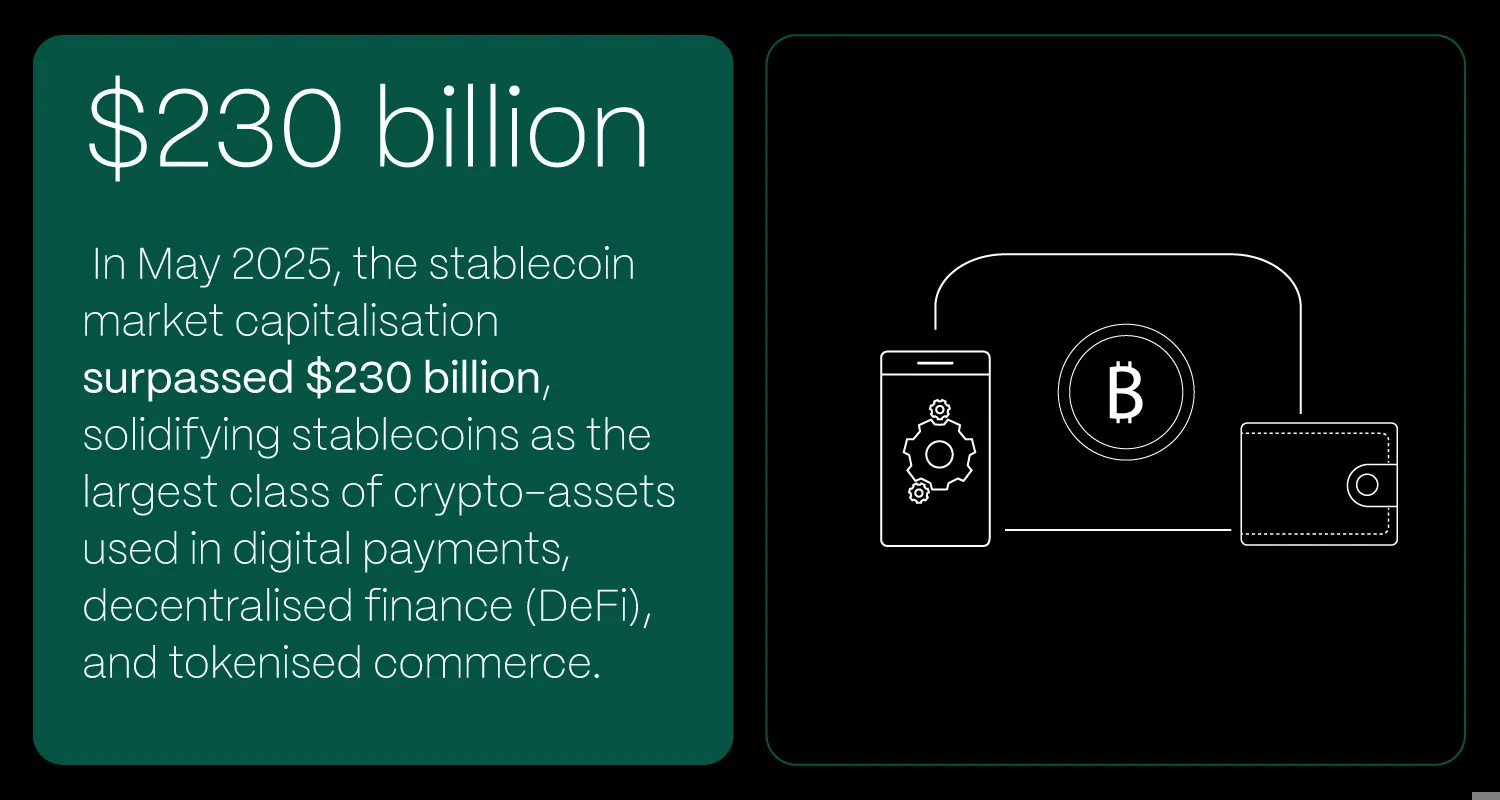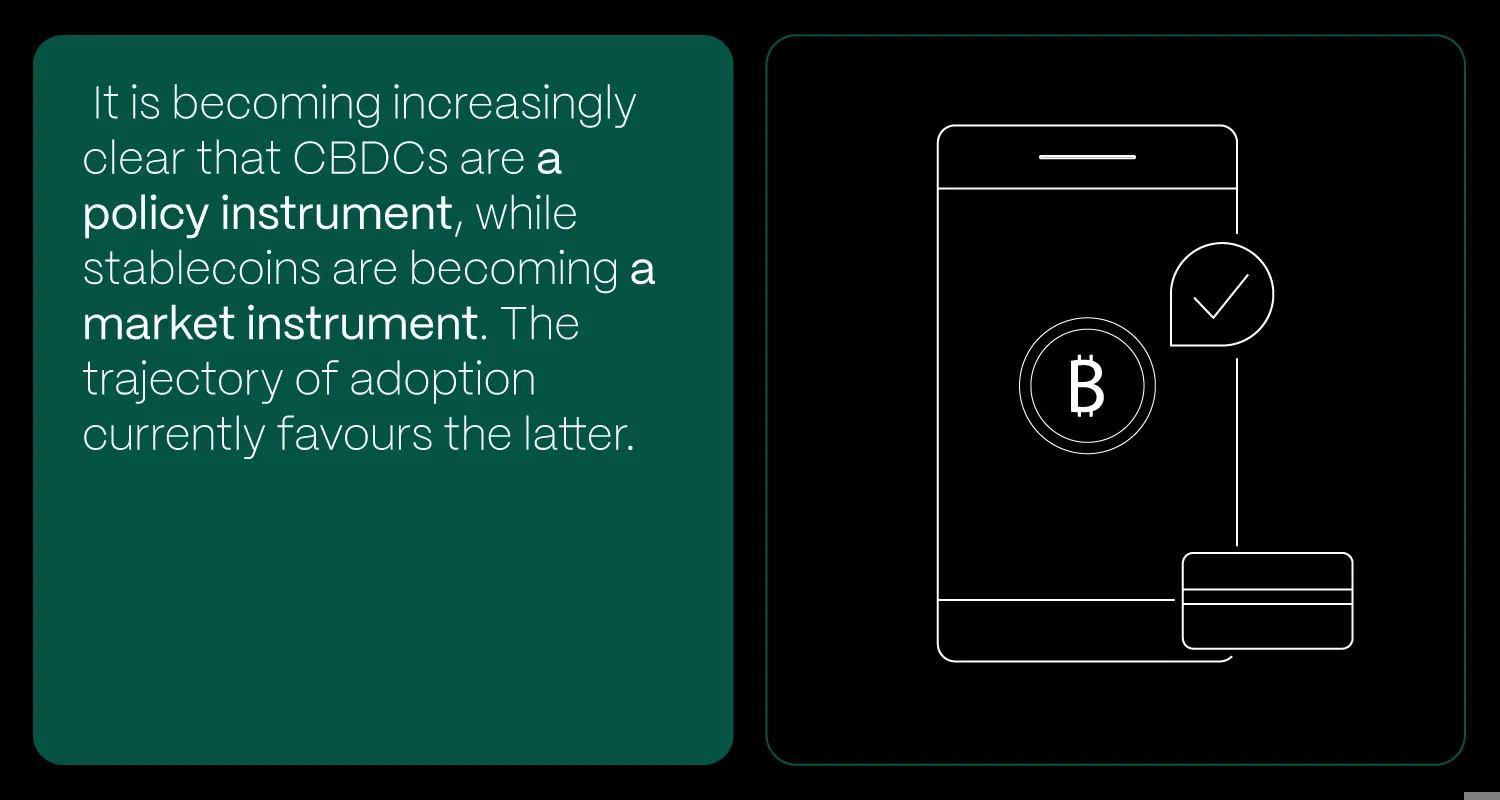Who will own the rails? Stablecoins and market power after GENIUS

Stablecoins are moving from innovation to infrastructure. The GENIUS Act creates the regulatory certainty needed for institutional use, but also shifts market power toward large issuers with the scale to operate under this regime. For businesses, the question is no longer whether stablecoins will be adopted, but which platforms they will have to depend on.
When I wrote about stablecoins last year, I was still asking myself whether they would compete with or complement central bank digital currencies (CBDCs). Now, in the final quarter of 2025, the picture is much clearer. CBDCs remain largely in pilot phases, while stablecoins are advancing rapidly in volume, adoption, regulatory clarity and institutional legitimacy.
The turning point has been the GENIUS Act, which has brought structure and transparency to a market that previously operated in a grey zone. For the first time, stablecoins have a federal legal identity, which has moved them from “crypto-adjacent” to “financial infrastructure.” Its introduction has not only legitimised stablecoins but also accelerated their adoption across businesses and institutions.
In this article, I examine how regulation, market momentum and real-world adoption beyond crypto are shaping the next stage of digital money. But the bigger story is not just growth – it is how regulation is reshaping market structure, who it advantages, and what that means for the next phase of adoption.
The GENIUS Act is where regulation meets market reality
The Guiding and Establishing National Innovation for U.S. Stablecoins Act (GENIUS Act) became law in July 2025. It is the first US federal statute to define clear rules for the issuance and management of payment stablecoins. Among its key provisions, the Act requires full reserve backing for issued coins, licensing for issuers, transparency of reserves and legal protections in case of insolvency.
This legislation matters because it provides something the market has long needed: legal certainty. It enables banks, fintechs and retailers that meet licensing standards to issue stablecoins with confidence. Issuers must provide monthly disclosures of reserve composition, while consumer protection and AML/KYC rules are rigorously enforced.
Strategically, the GENIUS Act represents a shift. Prior to its introduction, stablecoins were often perceived as speculative or fringe. Today, they are recognised as legally defined financial instruments that can operate safely within the payments and monetary system.
There are, of course, risks and criticisms. Some worry about over-centralisation of power, unequal access to licensing, or that the rules may favour large incumbents over innovators. Yet for many businesses, the trade-off is worth it: predictability and stability in return for certain regulatory constraints. This clarity is already driving institutional confidence and shaping the market’s next phase.
After GENIUS: The second-order consequences
The Act solves the legitimacy problem, but it does not solve the market concentration problem. By raising licensing, capital and compliance thresholds, GENIUS unintentionally narrows the field of viable issuers.
The most credible issuers post-GENIUS will be those with enormous balance sheets, regulatory muscle and distribution power, which tilts the market toward large fintechs and Big Tech rather than smaller innovators.
This shift matters for three reasons:
- Stablecoins risk becoming a “Big Tech payments utility” rather than a competitive open ecosystem.
- Innovation may move “upstream” to infrastructure players while startups become dependent on their rails.
- Market share may consolidate faster than regulators anticipated, creating new systemic dependencies – just in a different part of the financial stack.
The Act prevents misuse of reserves, but it does not prevent concentration of control. As a result, the industry’s centre of gravity is migrating from exchanges and crypto-native issuers toward large institutional or platform-based issuers with the scale to operate under banking-style oversight.
Growth and demand: From speculation to utility
Stablecoin market capitalisation has experienced significant growth. According to studies, in Q1 2025, the sector expanded by 8.6%, reaching approximately US$209.9 billion by March 3. Another research states that, by May 2025, this figure had surpassed US$230 billion, solidifying stablecoins as the largest class of crypto-assets used in digital payments, decentralised finance (DeFi), and tokenised commerce.
A key driver of this growth is the increasing integration of stablecoins into traditional financial markets. Notably, Tether (USDT) held approximately US$98.5 billion in the US. Treasury bills by Q1 2025, representing 1.6% of all outstanding Treasury bills. This positions Tether as one of the largest non-sovereign buyers in this critical asset class, comparable to nation-state-level investors.
The implication is not only scale, but leverage over underlying markets: as stablecoins absorb more Treasury supply, they become embedded in macro-liquidity dynamics. At that point, stablecoins are no longer just payment instruments, they are institutional balance-sheet actors.
The adoption of stablecoins is no longer confined to speculative trading. Businesses and individuals are increasingly utilising stablecoins for value preservation, cross-border transactions, and as a bridge between digital and traditional economies. This shift marks the transition from “crypto utility” to “financial infrastructure utility.”
For financial institutions, fintech companies, and enterprises, the implications are profound. Stablecoins are transitioning from experimental assets to embedded components of the global financial infrastructure. Embracing this transformation requires strategic planning, regulatory compliance, and technological adaptation to leverage not only the efficiency gains, but also the new risk surfaces of stablecoin integration. of stablecoin integration.
The real-world adoption of stablecoins
E‑commerce platforms are increasingly integrating stablecoin payment options, allowing merchants to accept digital dollars directly. Pilot projects with point-of-sale systems are also expanding, with companies such as Visa, Mastercard and Square testing stablecoin payments in retail environments. These initiatives aim to reduce transaction costs, accelerate settlement times and enable programmable money features.
Tokenisation is another important trend. Businesses are experimenting with internal stablecoins pegged to fiat currencies for supplier payments, employee incentives, or loyalty programs. This approach allows them to maintain a stable unit of value while benefiting from blockchain-based transaction efficiencies.
Recent research by PwC shows that approximately 12% of U.S. merchants are considering stablecoin acceptance within the next two years, and the global market for tokenised payments could exceed US$1 trillion by 2030 if adoption continues at current rates.
Implementation challenges remain. Integrating stablecoins with legacy systems, ensuring security, and maintaining compliance are non-trivial tasks. IT providers that can deliver secure API integrations, hybrid on-chain/off-chain settlement solutions, and auditable processes will play a critical role in supporting this transition.
Stablecoins are moving beyond the niche of crypto enthusiasts. They are proving themselves as functional instruments for real-world transactions, paving the way for a broader digital economy.
However, as adoption deepens, dependence on a small number of issuer rails becomes a structural risk factor. In other words, the long-term friction is not technical – it is concentration. Innovation moves fastest when entry barriers are low; GENIUS raises them.
CBDCs are still in the sandbox
Among G20 nations, none have fully launched a CBDC. However, 13 countries, including China, India, and several Eurozone nations, are actively piloting their digital currencies.
In India, the e-rupee pilot has seen significant growth. By March 2025, the digital rupee in circulation rose to ₹10.16 billion (approximately $122 million), a 334% increase from ₹2.34 billion in 2024.
Despite this progress, adoption remains limited. Challenges such as public awareness, trust, and the preference for existing payment methods hinder widespread use.
In contrast, regulated stablecoins are scaling more quickly than CBDCs because they plug into existing rails rather than redesigning them. Their growth and the regulatory clarity provided by the GENIUS Act have positioned them as practical tools for businesses and consumers.
While CBDCs continue to be tested and refined, stablecoins are already delivering real-world value. This divergence underscores the need for businesses to assess the evolving landscape and consider how these developments may impact their operations and strategies.
It is becoming increasingly clear that CBDCs are a policy instrument, while stablecoins are becoming a market instrument. The trajectory of adoption currently favours the latter.
What comes next
Looking ahead, the next phase of stablecoin evolution will not be defined only by adoption, but by how power concentrates around issuance, infrastructure and liquidity control.
The first trajectory is rapid adoption, where scale, network effects and compliance costs lock in a small group of dominant issuers.
The second one is controlled growth, where regulators continue tightening disclosure rules and stress-testing reserve management, effectively formalising stablecoins as a new layer of financial plumbing.
The third trajectory is jurisdictional fragmentation – particularly if the EU, the UK or the Middle East adopt materially different frameworks. This creates interoperability friction and could push cross-border flows into whichever regime offers the most permissive structure.
What businesses should do now?
My advice to business leaders today is not simply to monitor regulation, but to prepare for operating in a world where a handful of stablecoin issuers become critical infrastructure.
- Study the new regulatory frameworks in your jurisdictions. The GENIUS Act in the US is now a precedent. Comparable regimes are being considered globally.
- Choose credible partners. Issuers that publish full audits, maintain full reserves and operate under regulatory regimes you trust.
- Prioritise interoperability and vendor resilience. The UX layer depends on who controls the settlement layer. The smoother the fiat-stablecoin transition, the better. Users should not notice the complexity behind the scenes.
- Execute small pilots. Test stablecoin payments, supplier settlements, cross-border remittances. Learn from risk surfaces: security, reserve liquidity, and regulatory compliance.
Stablecoins are not displacing money. They are changing how it moves. The new question is not whether adoption will happen, but who will control the rails once it does.





